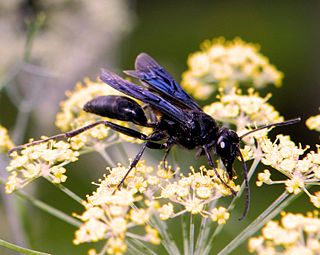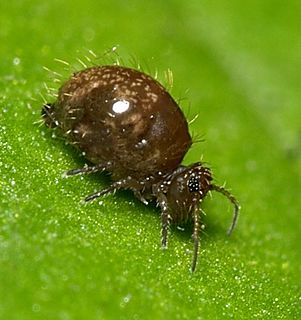
Hymenoptera is a large order of insects, comprising the sawflies, wasps, bees, and ants. Over 150,000 living species of Hymenoptera have been described, in addition to over 2,000 extinct ones. Many of the species are parasitic.

The Ichneumonidae, also known as the ichneumon wasps or ichneumonids, is a parasitoid wasp family within the insect order Hymenoptera. This insect family is among the most species-rich branches of the tree of life. At the same time, it is one of the groups for which our knowledge most severely lags behind their actual diversity. The roughly 25,000 species described today probably represent less than a quarter of their true richness, but reliable estimates are lacking, as is much of the most basic knowledge about their ecology, distribution and evolution. Ichneumonid wasps, with very few exceptions, attack the immature stages of holometabolous insects and spiders, eventually killing their hosts. They thus fulfill an important role as regulators of insect populations, both in natural and semi-natural systems, making them promising agents for biological control.

Beewolves, also known as bee-hunters or bee-killer wasps, are solitary, predatory wasps, most of which prey on bees, hence their common name. The adult females dig tunnels in the ground for nesting, while the territorial males mark twigs and other objects with pheromones to claim the territory from competing males.

The Xyelidae are a comparatively species-poor family of sawflies comprising about 80 extant species in five genera worldwide and is the only family in the superfamily Xyeloidea. The fossil record of the family is extensive, comprising more than 120 species and including the oldest fossil Hymenoptera species dating back to the Triassic, between 245 and 208 million years ago. Xyelidae are to be regarded as living fossils since they represent one of the oldest lineages of insects and include still extant forms.
Hygrobia is a genus of aquatic beetles native to Europe, North Africa, China and Australia. It is the only genus in the family Hygrobiidae, also known as the Paelobiidae. These are known commonly as squeak beetles or screech-beetles.

Adalia decempunctata, the ten-spotted ladybird or ten-spotted lady beetle, is a carnivorous beetle of the family Coccinellidae.

Allacma fusca is a species of springtail. This species is endemic to western areas of Continental Europe and the British Isles, where it lives in the surface layers of the soil in moist habitats such as among leaf litter.

Colletes hederae, the ivy bee, is a species of plasterer bee belonging to the family Colletidae subfamily Colletinae.

Scolia hirta is a species of wasp in the subfamily Scoliinae of the family Scoliidae.
Coleophora adspersella is a moth of the family Coleophoridae. It is found in most of Europe, except the Iberian Peninsula, Switzerland and Slovenia. It is also found in China. It occurs in forest and forest steppe biotopes, and in anthropogenic landscapes where the food plant occurs.

Tenthredo scrophulariae, the figwort sawfly is a species of the family Tenthredinidae, subfamily Tenthredininae.

Mutilla europaea, the large velvet ant, is a species of parasitoid wasps belonging to the family Mutillidae. It is a parasitoid on various species of bumblebees and is found in Europe, Asia and North Africa.

Phrynoponera is a strictly Afrotropical genus of ants in the subfamily Ponerinae.

Agrothereutes abbreviatus is a species of parasitic wasp belonging to the family Ichneumonidae.

Pyropterus nigroruber is a species of net-winged beetles belonging to the family Lycidae.

Auplopus albifrons is a spider wasp of the family Pompilidae.

Symmorphus allobrogus is a species of potter wasps belonging to the subfamily Eumeninae.

Meringopus calescens is a species of wasp belonging to the family Ichneumonidae first described by Johann Ludwig Christian Gravenhorst in 1829.

Leucospis dorsigera is a species of wasp belonging to the family Leucospidae.

Polistes associus is a species of paper wasps belonging to the family Vespidae.


















